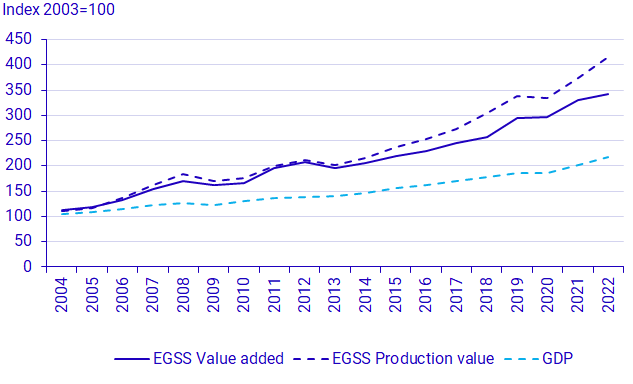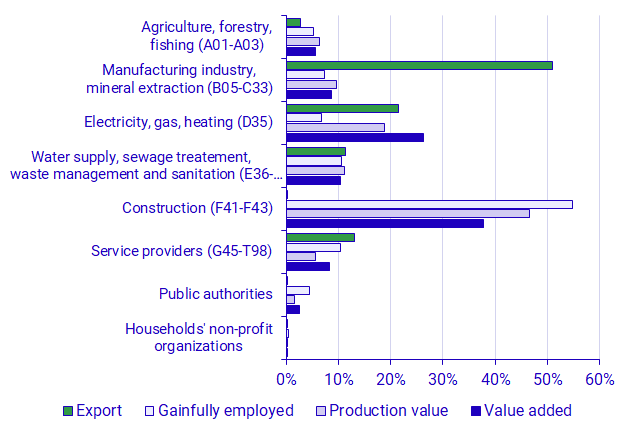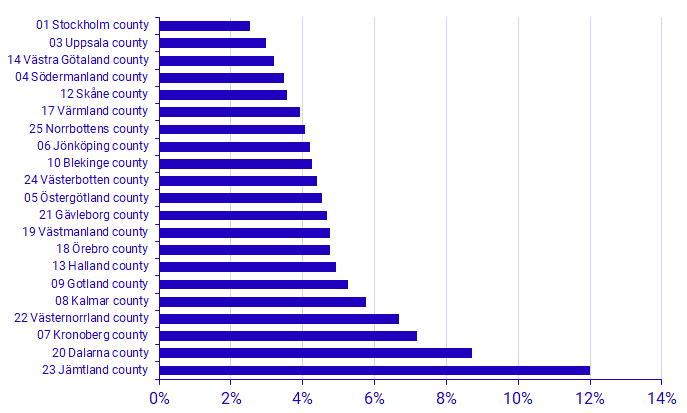Environmental Goods and Services Sector (EGSS) 2022
Continued growth for the environmental sector in 2022 (Corrected 2024-11-11)
Statistical news from Statistics Sweden 2024-10-17 8.00
The environmental goods and services sector accounts for 3,9 percent of Sweden’s total GDP. The production of environmental goods and services during 2022 increased by 3,6 percent from the previous year. The increase comes mainly from the construction sector, industries within petroleum and coal products and from the chemical and pharmaceutical industry. The production of environmentally friendly goods and services employs roughly 169,000 people, 80 percent of whom are men.
Statistics on the environmental goods and services sector describe the part of Sweden’s economy that produces environmentally friendly goods and services. The environmental sector includes the production of goods and services for environmental protection and sustainable resource management.
The increase in the environmental sector's added value that comes from the industries within petroleum and coal products as well as the chemical and pharmaceutical industry (NACE C19-C21) can largely be derived from biofuel production. The production of environmentally friendly goods and services, measured as added value, amounts to 226 billion SEK in 2022 which is 3,9 percent of Sweden´s GDP. This can be compared to the beginning of the time series in 2003 where the environmental sector amounted to 2,5 percent. The energy sector and energy saving activities represent the environmental areas with the highest impact on added value and production value. The construction of passive buildings by the construction branch has an especially high impact on this area.
The production of environmentally friendly goods and services, measured as production value, increases in 2022 and amounts to 665 billion SEK in current prices. The production value between 2013 and 2022 in the environmental sector increased by 341 billion SEK, mainly due to increases in the construction and energy industries. Since 2003, the production value in the environmental sector has more than tripled in current prices.

Source: Statistics Sweden, Environmental Accounts and National Accounts.
The construction industry contributes the most to production
Statistics on the environmental sector are also broken down by industry (NACE rev.2). The energy and construction industries as well as companies within drainage, waste and sanitation are the industries that contribute the most to employment, production value and value added for the environmental sector in 2022. The construction industry includes the building of nearly-zero energy buildings according to guidelines from the European Statistical Office, Eurostat. Companies in forestry and logging also form a large share of the environmental sector.
The labour force in the environmental sector is mainly located among construction (55 %). Statistics on the environmental sector also estimate exports of goods and services from the environmental sector. Exports for the environmental sector are mainly dominated by goods and services from the manufacturing sector (51 %).

Source: Statistics Sweden, Environmental Accounts.
The environmental sector’s share of the economy is largest in Jämtland
Statistics on the environmental sector are also available per county. Metropolitan regions account for the highest total value added, production value and number of persons employed. However, when value added is normalised as share of the gross regional product (GRP), a reversed picture emerges. The highest value added as share of GRP for the environmental sector is found in the counties of Jämtland, Dalarna, Kronoberg and Västernorrland.

Source: Statistics Sweden, Environmental and National Accounts.
Definitions and explanations
Environmental accounts are organised using national accounts as a base to enable reporting on environmental statistics and economic statistics in a common system. The environmental accounts, which are a UN-based statistical standard, provide opportunities for analysing connections between the economy and the environment, in particular through the use of industries that are reported according to the Swedish Industrial Classification (SNI).
Statistics Sweden’s Environmental accounts
Statistics on the environmental sector form part of the environmental accounts framework. Since 2017, under the regulation on European environmental accounts, it is mandatory for EU Member States to report these statistics annually to Eurostat. However, Statistics Sweden has published statistics on dates earlier than this, where statistics are available as early as 2003. In connection with the publication in 2018, the statistics were revised to better align with new guidelines and to be more closely integrated with the national accounts. This also enables deeper national and international comparisons, such as the environmental sector’s contribution to the Swedish economy. In addition to the national accounts data, data on company finances is used to describe net turnover, data from BAS (Population by Labour market status) to describe gainful employment, and data from foreign trade statistics to describe exports.
Statistics on the environmental sector are based on a micro-database of companies and workplaces that produce environmentally friendly goods and services. However, a model approach is used for the agriculture (A01), the forest (A02) and the construction (F41-43). For agriculture, the statistics are based on organic farming. For forestry and logging, statistics on the environmental sector are based on certified forestry. For construction operations, statistics on the environmental sector are based on data on nearly-zero energy buildings.
The statistics follow Eurostat’s environmental sector handbook, which contains definitions of which economic activities and products are included in the environmental sector. Examples of economic activity included are production of renewable energy, wastewater treatment, waste management, sanitation, environmental consultants, and organic farming. Examples of economic activity not included are wholesale of waste products, nuclear power, and public transport.
To read more on definitions and delimitations, see Eurostat’s handbook:
Next publishing will be
The environmental sector up to reference year 2023 will be published during the fall of 2025.
Statistical Database
More information is available in the Statistical Database
Feel free to use the facts from this statistical news but remember to state Source: Statistics Sweden.
